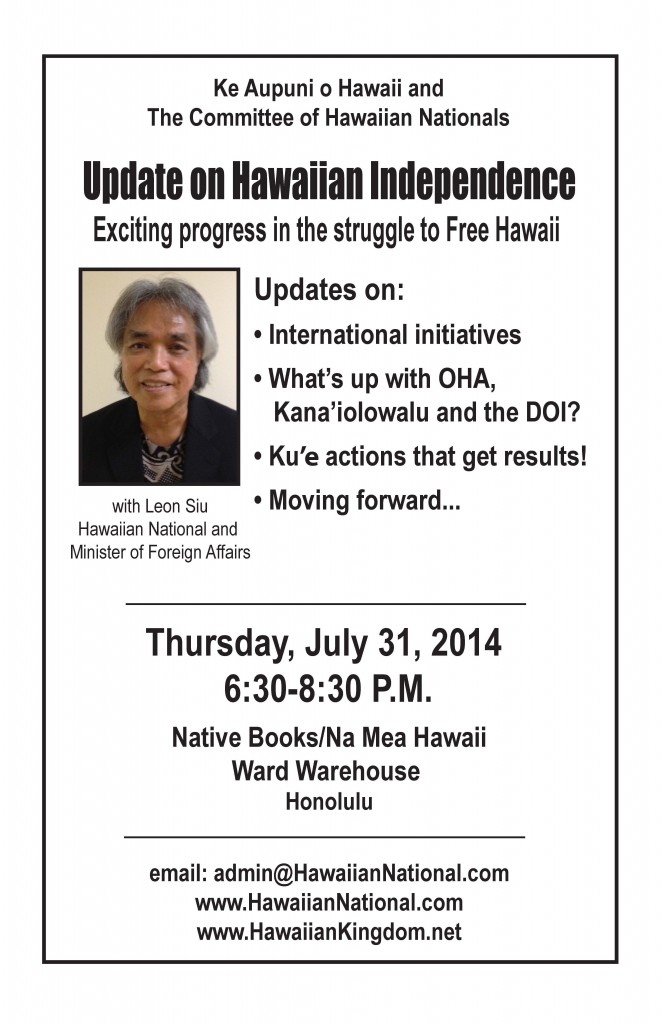
|
||||||
|
Dr. Lynette Cruz and Dr. Keanu Sai discuss his doctoral research on the occupation of Hawai‘i and how to ultimately bring the occupation to an end. Also discussed was Dr. Sai’s recent letter to Assistant Secretary of Insular Affairs at the Department of the Interior, Esther Kia‘aina, regarding evidence that Hawai‘i’s sovereignty was lost in 1893. In The Hawaii Independent, ʻUmi Perkins takes us through the history of today’s national holiday celebrating the return of sovereignty. Lynette Cruzʻs photos from Ka Lā Hoʻihoʻi Ea, Sovereignty Restoration Day at Thomas Square on Saturday.
Wai‘anae Film Series Friday, July 25 Kamehameha Schools 5:00pm – Pupus and dinner Featured Films: Hawai‘i: A Voice for Sovereignty; The End of Poverty; Life and Debt Featured Guest Speakers: Jon Osorio from Kamakakūokalani Center for Hawaiian Studies at UH Mānoa and MANA and Ilima Long from MANA THIS EVENT IS FREE AND OPEN TO THE PUBLIC Please RSVP to waianaefilmseries@gmail.com or 454-4713 so that we can provide food for everyone Cosponsors: Senator Maile Shimabukuro, AiKea, DMZ Hawai‘i/Aloha ‘āina, Hawai‘i Peace and Justice, UH Mānoa Hawai‘inuiākea, KAHEA: The Hawaiian-Environmental Alliance, MANA: movement for aloha no ka ‘āina, and the Wai‘anae Environmental Justice Working Group. Planning Committee: Pua Ford, Lucy Gay, Summer Miles, Ileana Ruelas, Pake Salmon, Laurel Mei Turbin. Food provided by Maimun. The political views expressed in this program do not represent the views or opinions of KSBE or any of its affiliates. Hawaii’s Place in Oceania:Past, Present, and FutureLorenz Gonschur, PhD CandidatePolitical ScienceUniversity of Hawaii at ManoaJuly 24, 2014, Thursday, 5:00 pm
Olelo Community Media Center · 1122 Mapunapuna St. \Hawaii’s historical and political situation is best understood within the context of the region of Oceania to which the archipelago naturally belongs. Put in this perspective, the unique position of Hawai’i as the first and only fully recognized nation-state in Oceania during the nineteenth century can be clearly seen. Gonschur’s research follows this perspective, from strategies of national independence movements in Hawai’i, Tahiti and Rapa Nui, to state formation and nation-building in Oceania during the nineteenth century, comparing Hawai’i to the other major archipelagos of the region, such as Samoa, Tonga, and Fiji. There are nuances between occupation (applicable to Hawai’i) and colonization (applicable to Tahiti and Rapa Nui). During the nineteenth century the Hawaiian Kingdom was a model for successful nation-building that other Pacific Islands tried to emulate. Pacific regionalism, a very important and contested issue throughout the region today, has its roots in the pro-active foreign policy of the Hawaiian Kingdom to support and promote nation-building all across Oceania and keep the region free of outside imperial powers. Seventh in a series of presentations on new research into Hawaiian Kingdom history Sponsored by Ka Lei Maile Alii Hawaiian Civic Club, with funding from the Office of Hawaiian Affairs Ample parking in the Olelo Community Media Center parking lot and on the street For more information: palolo@hawaii.rr.com, phone (808) 284-3460 Seating is limited This event is free and open to the public |
||||||
|
Copyright © 2025 Hawaiian Kingdom Independence Blog - All Rights Reserved Powered by WordPress & Atahualpa |
||||||




